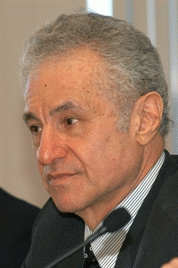On August 6, 1945, the United States Army Air Force dropped an atomic bomb on Hiroshima, Japan, and three days later on August 9, 1945, the USAAF dropped another atomic bomb on Nagasaki, Japan. The death and destruction these two bombs wrought was immense, but it was no greater than the death and destruction previously wrought by the aerial fire-bombings of Germany and the Japanese mainland by the Allies in 1944 and 1945. What was new about the atomic bombings was that a single bomb caused so much damage and loss of life, and it could (obviously) be delivered by a single airplane. It was also suspected that missiles of the type developed late in the war by Germany would be capable of delivering atomic bombs to their targets in the near future.
The atomic bombings of Japan were followed almost immediately by her surrender and the end of World War II, and for twenty years there was a consensus among American historians that the bombings were necessary to cause Japan� �� � s surrender without an invasion of the Japanese mainland by American troops, an invasion that the American military predicted would result in hundreds of thousands of American dead and wounded.Â
But in the late 1960� �� � s, a school of � ���"revisionist� �� � historians arose, who argued that: (1) by July, 1945, Japan� �� � s surrender was immanent; and, (2) the atomic bombings were not necessary to obtain Japan� �� � s surrender on the same terms as actually obtained after the bombings, and this was known by the American government on August 6, 1945; and yet, (3) in order to convince the USSR both that America had the military might to oppose expansion by the Soviets anywhere in the world (and especially in Western Europe) - and to convince the USSR that America was prepared to use atomic bombs against her - the United States dropped the two atomic bombs on Japan.
The dean of this revisionist school of the history of the atomic bombings is Gar Alperovitz, Lionel R. Bauman Professor of Political Economy at the University of Maryland, in College Park, Maryland.*Â
It is less clear who is dean of the American school of traditional history regarding the necessity of dropping the two nuclear bombs on Japan in order to end the war without an American invasion of mainland Japan, but certainly a good candidate is John Lewis Gaddis, Robert A. Lovett Professor of Military and Naval History at YaleUniversity.**Â
I strongly side with Gar Alperovitz and the revisionist school, but as almost 65 years of American hegemony in the world draws to a close, these arguments over its beginnings seem increasingly irrelevant. In this article I try to say something new with pictures, since pictures may be worth several words per pixel, and to say something which can best be brought home by the article� �� � s pictures. To wit, the use of atomic bombs can end all human life on the planet earth, and it must be brought under international control before it does so. Â
There follow two actual pictures of the mushroom clouds rising from the bombings of Japan, and one picture of the United States� �� � hydrogen bomb test in the Bikini Atoll in 1954, all three from Wikipedia. The three photographs are followed by three charcoal-on-paper works by the artist Robert Longo; Longo� �� � s works depict the mushroom cloud from the atomic bomb over Nagasaki, Japan, on August 9, 1945; the first Soviet nuclear test� �� � s mushroom cloud, over Semipalatinsk, Kazakhstan, near the Siberian border, in 1949; and an undated American test of a nuclear weapon in the Marshall Islands.***
Actual photographs of the mushroom clouds over Hiroshima and Nagasaki, Japan, on August 6, 1945 and August 9, 1945, and The United States� �� � biggest Bikini Atoll test explosion, in 1954:
"I think I make art for brave eyes. I don't want to make art that will pat you on the back and tell you everything is going to be okay.  I want to make something that's much more confronting� �� �.It looks at you as much as you look at it. - Robert Longo (1986)� �� � Â
(Note: You can view every article as one long page if you sign up as an Advocate Member, or higher).





